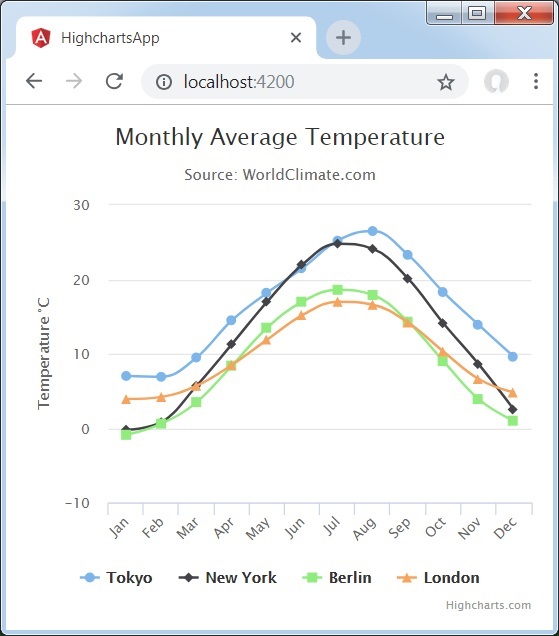
- Angular Highcharts - Home
- Angular Highcharts - Overview
- Environment Setup
- Configuration Syntax
- Angular Highcharts - Line Charts
- Angular Highcharts - Area Charts
- Angular Highcharts - Bar Charts
- Angular Highcharts - Column Charts
- Angular Highcharts - Pie Charts
- Angular Highcharts - Scatter Chart
- Angular Highcharts - Dynamic Charts
- Angular Highcharts - Combinations
- Angular Highcharts - 3D Charts
- Angular Highcharts - Map Charts
Angular Highcharts - Configuration Syntax
In this chapter, we will showcase the configuration required to draw a chart using the Highcharts API in Angular.
Step 1 - Create Angular Application
Follow the following steps to update the Angular application we created in Angular 6 - Project Setup chapter −
| Step | Description |
|---|---|
| 1 | Create a project with a name highchartsApp as explained in the Angular 6 - Project Setup chapter. |
| 2 | Modify app.module.ts, app.component.ts and app.component.html as explained below. Keep rest of the files unchanged. |
| 3 | Compile and run the application to verify the result of the implemented logic. |
Following is the content of the modified module descriptor app.module.ts.
import { BrowserModule } from '@angular/platform-browser'; import { NgModule } from '@angular/core'; import { AppComponent } from './app.component'; import { HighchartsChartComponent } from 'highcharts-angular'; @NgModule({ declarations: [ AppComponent, HighchartsChartComponent ], imports: [ BrowserModule, ], providers: [], bootstrap: [AppComponent] }) export class AppModule { }
Following is the content of the modified HTML host file app.component.html.
<highcharts-chart [Highcharts] = "highcharts" [options] = "chartOptions" style = "width: 100%; height: 400px; display: block;"> </highcharts-chart>
We'll see the updated app.component.ts in the end after understanding configurations.
Step 2 − Use Configurations
Create Highcharts and create chartOptions
highcharts = Highcharts; chartOptions = { }
Create Chart
Configure the type, title and sub-title of the chart using chartOptions.
chart: { type: "spline" },
xAxis
Configure the ticker to be displayed on the X-Axis using chartOptions.
xAxis:{ categories:["Jan", "Feb", "Mar", "Apr", "May", "Jun", "Jul", "Aug", "Sep", "Oct", "Nov", "Dec"] },
yAxis
Configure the title to be displayed on the Y-Axis using chartOptions.
yAxis: { title:{ text:"Temperature °C" } },
tooltip
Configure the tooltip. Put suffix to be added after value (y-axis) using chartOptions.
tooltip: { valueSuffix:" °C" },
series
Configure the data to be displayed on the chart using chartOptions. Series is an array where each element of this array represents a single line on the chart.
series: [ { name: 'Tokyo', data: [7.0, 6.9, 9.5, 14.5, 18.2, 21.5, 25.2,26.5, 23.3, 18.3, 13.9, 9.6] }, { name: 'New York', data: [-0.2, 0.8, 5.7, 11.3, 17.0, 22.0, 24.8,24.1, 20.1, 14.1, 8.6, 2.5] }, { name: 'Berlin', data: [-0.9, 0.6, 3.5, 8.4, 13.5, 17.0, 18.6, 17.9, 14.3, 9.0, 3.9, 1.0] }, { name: 'London', data: [3.9, 4.2, 5.7, 8.5, 11.9, 15.2, 17.0, 16.6, 14.2, 10.3, 6.6, 4.8] } ]
Example
Consider the following example to further understand the Configuration Syntax −
app.component.ts
import { Component } from '@angular/core'; import * as Highcharts from 'highcharts'; @Component({ selector: 'app-root', templateUrl: './app.component.html', styleUrls: ['./app.component.css'] }) export class AppComponent { highcharts = Highcharts; chartOptions = { chart: { type: "spline" }, title: { text: "Monthly Average Temperature" }, subtitle: { text: "Source: WorldClimate.com" }, xAxis:{ categories:["Jan", "Feb", "Mar", "Apr", "May", "Jun", "Jul", "Aug", "Sep", "Oct", "Nov", "Dec"] }, yAxis: { title:{ text:"Temperature °C" } }, tooltip: { valueSuffix:" °C" }, series: [ { name: 'Tokyo', data: [7.0, 6.9, 9.5, 14.5, 18.2, 21.5, 25.2,26.5, 23.3, 18.3, 13.9, 9.6] }, { name: 'New York', data: [-0.2, 0.8, 5.7, 11.3, 17.0, 22.0, 24.8,24.1, 20.1, 14.1, 8.6, 2.5] }, { name: 'Berlin', data: [-0.9, 0.6, 3.5, 8.4, 13.5, 17.0, 18.6, 17.9, 14.3, 9.0, 3.9, 1.0] }, { name: 'London', data: [3.9, 4.2, 5.7, 8.5, 11.9, 15.2, 17.0, 16.6, 14.2, 10.3, 6.6, 4.8] } ] }; }
Result
Verify the result.
